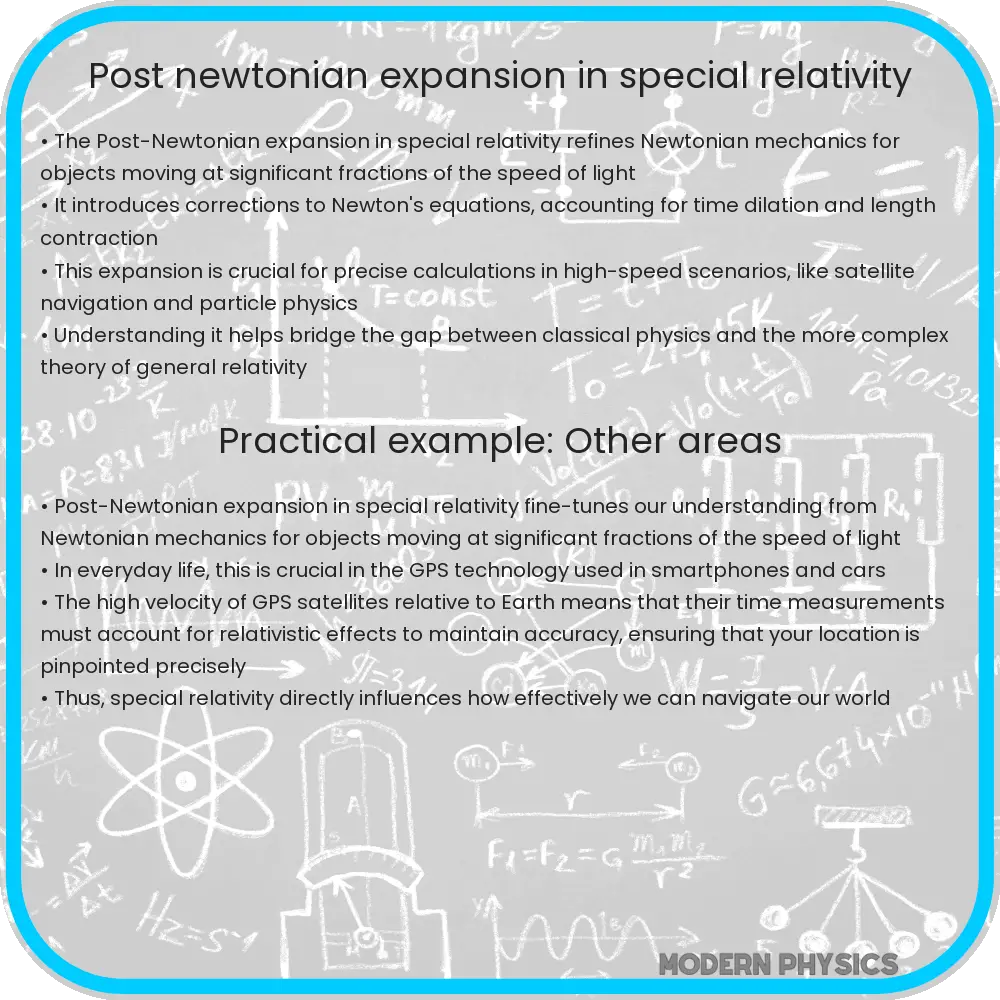Explore the Post-Newtonian Expansion, a crucial tool blending Newtonian mechanics with relativity for astrophysical phenomena and GPS accuracy.

Understanding Post-Newtonian Expansion: Bridging Classical and Relativistic Physics
The realm of astrophysics and cosmology often demands a fusion of classical Newtonian mechanics with Einstein’s theory of relativity to accurately describe the motion of bodies in weak gravitational fields. This synthesis is achieved through the Post-Newtonian Expansion, a powerful analytical tool used to approximate the equations of general relativity in conditions where gravitational fields are not extremely strong.
Basics of Post-Newtonian Expansion
At its core, Post-Newtonian Expansion is an iterative method of solving the field equations of general relativity. The expansion is typically carried out in powers of (v/c)2, where v represents the velocity of a moving body and c is the speed of light. This approach is valid when (v/c)2 is much smaller than 1, implying that the velocities involved are significantly less than the speed of light, a condition often met in astrophysical contexts.
Accuracy and Relativistic Effects
The accuracy of Post-Newtonian Expansion is contingent upon the order of the expansion. The higher the order, the more terms are included, enhancing the precision of the approximation. This method meticulously incorporates relativistic effects like time dilation, gravitational redshift, and the deflection of light. These corrections are crucial for explaining phenomena such as the perihelion precession of Mercury and the gravitational waves detected by observatories like LIGO and Virgo.
The Mathematics Behind Post-Newtonian Expansion
The mathematical intricacies of Post-Newtonian Expansion involve expanding the metric tensor of spacetime, a key concept in general relativity, in powers of (v/c)2. This expansion yields a series of equations that progressively approximate Einstein’s field equations. The first order, known as the Newtonian limit, corresponds to classical physics. Subsequent orders introduce corrections that account for relativistic effects. Solving these equations provides insights into the dynamics of systems like binary star systems and the behavior of light in gravitational fields.
Through Post-Newtonian Expansion, physicists are able to bridge the gap between the intuitive concepts of Newtonian mechanics and the more complex, yet more accurate, framework of general relativity. This approach offers a pragmatic solution for studying a wide range of astrophysical phenomena, where the effects of relativity cannot be ignored, but the full machinery of Einstein’s theory is not necessary.
Applications in Modern Astrophysics
Post-Newtonian Expansion has become indispensable in modern astrophysics, particularly in the study of systems where relativistic effects are significant but not dominant. One prominent application is in the analysis of binary pulsars. These systems provide natural laboratories for testing the predictions of general relativity, including the emission of gravitational waves. By applying the Post-Newtonian framework, astrophysicists can accurately model the orbital decay of these systems due to gravitational wave emission, a prediction that has been confirmed by observations.
Improving GPS and Space Missions Accuracy
Another practical application of Post-Newtonian Expansion is in the field of satellite-based navigation systems like GPS. The accuracy of GPS relies on accounting for both special and general relativistic effects, which affect the synchronization of clocks on satellites and on the Earth. Post-Newtonian calculations are essential to correct these time discrepancies, ensuring the high precision required for navigation and timing services.
Challenges and Future Prospects
Despite its effectiveness, the Post-Newtonian approach faces challenges, particularly in systems involving strong gravitational fields, like those near black holes. In these regimes, higher-order terms become increasingly significant, and the complexity of calculations escalates. Future developments in computational techniques and the advent of more powerful computers are expected to enhance the capability and scope of Post-Newtonian Expansion, enabling more precise modeling of extreme astrophysical phenomena.
Conclusion
The Post-Newtonian Expansion is a testament to the elegance and utility of theoretical physics in deciphering the cosmos. By seamlessly blending Newtonian mechanics and Einstein’s relativity, it provides a pragmatic and powerful tool for understanding a wide array of astrophysical phenomena. Its applications, ranging from explaining the nuances of orbital mechanics in binary pulsars to refining the accuracy of GPS technology, underscore its significance in both theoretical and practical domains. As we continue to explore the universe, the Post-Newtonian Expansion will undoubtedly play a pivotal role in unveiling the mysteries of the cosmos, standing as a bridge between the familiar world of classical physics and the enigmatic realm of relativity.
Is this conversation helpful so far?
